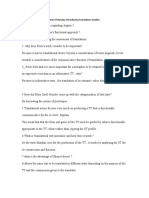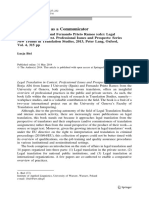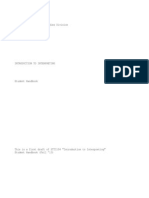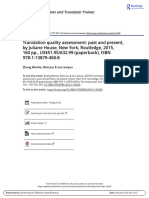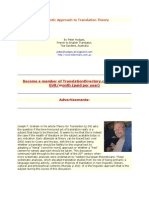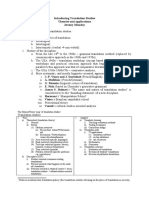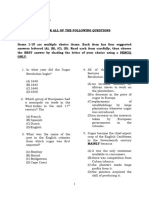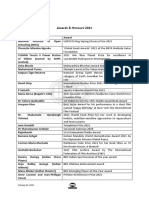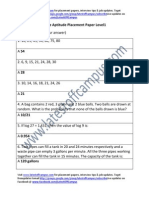Translation Resources
This guide aims at introducing students to the field of Translation Studies
by providing them with an overview of the field: branches, key theories,
current research trends, and an extensive reading list. The guide also
provides students with the necessary practical tools to undertake multiple
processes of specialized translation, focusing on three of the prominent
areas of translation: legal, business, and medical. This guide prepares
students for conducting research in Translation Studies as well as
improving their practical translation skills.
A- Branches of Translation Studies:
Holmes’s Map of Translation Studies (Holmes, 1972; Toury, 1991: 181; 1995: 10)
2
�Translation Resources
B- Key Theorists in Translation Studies:
Theorist Theory Summary
2- Category shift
Structural shift: a shift in the
1- Level shift: grammatical structure
Something that is
expressed by
Catford Translation gramar in one Class shift: a shift from one part
language and lexis of speech to another
(1956) Shift in another
Unit shift: changing the rank of
the equivlance in the TT
Intra-system shifts: shifts where
the translation involves a non-
corresponding term in the TL
system
Direct translation Oblique
(literal) Translation (free)
Borrowing: the SL Transposition: changing one
word is transferred part of speech for another
directly to the TL without changing the sense
(obligatory or optional)
Calque: a special Modulation: changing the
kind of borrowing semantics and point of view of
when the SL word is the SL (obligatory or optional)
Vinay and Literal and transferred in a
Darbelnet free literal translation Equivalence: describing the
(1958) translation same situation by different
stylistic or structural means
Literal: word-for-word
translation Adaptation: changing the
culltural refrence when a
situation in the ST does not
exist in the TT
3
�Translation Resources
His theory follows the langue and parole theory of language
Linguistic proposed by Saussure. Langue (signifier, the spoken and
approach: written signal) and parole (signified the concept). He argues
Linguistic that different languages differ in the way they convey
Jakobson
meaning meaning but they share the way of experiencing and thinking
(1960s)
and because of linguistic universality.
equivalence He also raised the issue of translatability arguing that what is
theory translated is the message not the code units only.
Nida built his theory on Chomsky's generative –
transformational model. The deep structure of a sentence in
the SL is transformed into a surface structure into the TL.
Therefore, the Kernel is the basic element of the sentence
Linguistic that should be rendered into a surface structure sentence.
approach: At the word level, a word is dealt with according to its context
and culture.
Scientific Semantically and pragmatically, meaning is divided into:
theory of
• Linguistic meaning: seeing association between
Nida (1960s) translation
different linguistic structure (his)
• Referential meaning: denotative dictionary meaning
Theory of
formal and • Emotive or connotative meaning: the association the
dynamic word creates according to its pragmatic use
equivalence Another theory is formal and dynamic equivalence. Formal
equivalence is concerned with form and content focusing on
SL message. However, dynamic equivalence focuses on
having the same equivalent effect of the SL into the TL.
Equivalence at the text level, linking language functions to
text types and translation strategy. The functional approach
involves four functions of language:
1. Informative function (representing objects and facts).
The content is the main focus of the communication.
“Plain prose” is the translation method used for this
text type.
Reiss Functional 2. Expressive function (expressing sender’s attitude).
(1970s) theory
The form of the message is the main focus.
“Identifying” method, adopt perspective of the ST
author.
3. Appellative function (making an appeal to the text
receiver). The form of language is dialogic, and the
focus is appellative. “Adaptive” equivalent effect is the
suitable translation method.
4
� Translation Resources
4. Audio-medial texts require what Reiss calls the
“supplementary” method, supplementing written words
with visual images and music.
Vermeer Skopos Translation decisions are mainly shaped by the purpose of
(1970s) theory the TT.
Polysystem
Even-Zohar Perceives translated literature as part of the culture, literary
Theory
(1970s) and historical system of the TL.
Communicative translation should attempt to render the same
effect obtained by the original reader (dynamic equivalence)
Semantic and semantic translation focuses on rendering the same
and meaning of the original (formal equivalence).
Newmark communicati • The semantic approach is appropriate for serious
(1980s) ve literature, autobiography, and any political statement.
translation Translation remains in the SL culture
theory • The communicative approach is appropriate for the
vast majority of texts, and transfers foreign elements
into the TL culture
Correspondence translation is more related to comparing two
languages, whereas equivalence is related to specific
equivalents between ST-TT pairs and contexts.
There are five types of equivalence relations:
1- Denotative equivalence: equivalence of extralinguistic
Equivalent
Koller content of a text
relations
(1980s) 2- Connotative equivalence: stylistic equivalence, lexical
theory
choices
3- Text-normative equivalence: text types
4- Pragmatic equivalence: communicative equivalence
directed to the receiver of the message
5- Formal equivalence: related to the aesthetics of the text
DTS examines:
1-Product-oriented DTS (The description or analysis of a
single ST-TT pair or a comparative analysis of several TTs of
the same ST into one or more TLs)
Descriptive
2- Function-oriented DTS (The descriptive of the function in
Translation
Holmes (1988) the recipient sociocultural situation: it is a study of contexts
Studies
rather than texts)
(DTS)
3- Process-oriented DTS (This type is concerned with the
psychology of translation, what happens in the mind of
translators)
5
� Translation Resources
Descriptive
Puts forward a systematic methodology for (DTS) as a non-
Translation
perspective means of understanding the norms at work in the
Toury (1995) Studies
translation process and of discovering the general laws of
(DTS)
translation.
The recently Studies translation as a field that involves agents of various
integrated levels of power. Such field interacts with other fields in the
sociological social space, which shapes both macro and micro translation
approaches to decisions.
Social fields
Translation
Studies
Bourdieu
(1977)
Social Similar to social fields, this approach analyses translation with
Luhmann system its relevant social system, focusing mainly on the non-human
(1995) theory agents.
(SST)
Actor- Adopts a sociological view of translation; however, treats
network human and non-human agents equally.
Latour (1996)
theory
(ANT)
C- Contemporary Research Trends:
• Sociology of translation
• Audiovisual translation (AVT)
• Machine translation (MT)
• Computer-assisted translation (CAT tools)
• Ethical issues in translation and technology
• Corpus-based translation studies
• Multimodality in translation and interpreting studies
• Sociotechnical practices of translation and interpreting
• Translation and social media
• Translation and memory
• Changes in translation pedagogy: online delivery and blended
learning
6
�Translation Resources
D- Digital Tools:
D.1 General Dictionaries
• Cambridge dictionary (English-Arabic):
https://dictionary.cambridge.org/dictionary/english-arabic/
• Arab dictionaries: http://www.arabicdictionaries.com/
• A multilingual e-translation portal:
http://www.logos.it/language/translations_en.html
• Alburaq dictionary: http://www.alburaq.net/dictionary/transform.cfm
• Almaany dictionaries: https://www.almaany.com/ar/dict/ar-en/
• Sakhr software: http://www.sakhr.com (includes dictionaries)
D.2 Legal Resources
• The Saudi Official Translation Division (OTD):
https://www.boe.gov.sa/en/Translation/Pages/GovernmentLabels.a
spx
• The United Nations Multilingual Terminology Database:
http://unterm.un.org/
• Law.com: http://dictionary.law.com/
• The United Nations documentation centre:
http://www.un.org/en/documents/index.shtml
• Legal dictionaries (McGill University):
https://libraryguides.mcgill.ca/c.php?g=717457&p=5123702
• Legal Information Institute (Wex):
http://www.law.cornell.edu/wex/index.php/Contracts
• World bank: http://www.worldbank.org/
7
�Translation Resources
D.3 Business/Commercial Resources
• English to Arabic Business Translation Glossary (Proz):
https://www.proz.com/glossary-translations/english-to-arabic-
translations/business-commerce-general
• Commercial Terminologies Dictionary (Almaany):
https://www.almaany.com/dicload/Commercial%20Terminologies.pdf
• International Arbitration Information by Aceris Law LLC:
https://www.international-arbitration-attorney.com/ar/icc-incoterms-
in-international-trade/
• Union of Arab Securities Authorities (Glossary):
https://www.pcma.ps/portal/awareness/Lists/Awareness_Pubs_List
/Attachments/47/UASA_Glossary_Final_2018.pdf
• Capital Market Authority Guide:
https://cma.org.sa/Awareness/Publications/booklets/Booklet_10.pd
f
• Islamic Finance Glossary (CIMA):
https://issuu.com/cimaglobal/docs/islamic_finance_glossary
D.4 Medical Resources
• HTH Worldwide Arabic Medical Translation Guide:
https://medicine.biu.ac.il/sites/medicine/files/shared/common_medi
cal_terms_sorted_by_arabic.pdf
• UMD: The Unified Medical Dictionary (English-Arabic):
https://apps.who.int/iris/handle/10665/119845 /
https://umd.emro.who.int/whodictionary
• National Health Information Centre (glossary):
https://nhic.gov.sa/Initiatives/Pages/TheSaudiDictionaryforHealthD
ata.aspx
• Tabeeb dictionary: https://www.tbeeb.net/طبي-قاموس/
• Psychiatry and Psychology dictionary:
http://arabpsynet.com/HomePage/Psy-Dict.Ar.htm
8
�Translation Resources
E- Translation Studies Reading List:
E.1 Core Sources
Baker, Mona and Gabriela Saldanha (ed.) (2020) Routledge Encyclopaedia of
Translation Studies. London: Routledge.
Baker, Mona (2011) In other words: A coursebook on translation. London:
Routledge.
Bassnett, Susan (1980, 1991, 2002, 2014) Translation studies. London: Routledge.
Bermann, Sandra and Catherine Porter (eds) (2011) A Companion to Translation
Studies. London: Wiley-Blackwell.
Boase-Beier, Jean (2011) A critical introduction to translation studies. London and
New York: Continuum.
Chan, Sin-Wai (ed.) (2015) Routledge Encyclopaedia of Translation Technology.
Abingdon, Oxon: Routledge.
Chesterman, Andrew and Jenny Williams (2002) The Map. A Beginner’s Guide to
Doing Research in Translation Studies. Manchester and Kinderhook, NY: St
Jerome Publishing.
Dickins, James, Hervey, Sándor and Ian Higgins (2016) Thinking Arabic translation:
A course in translation method: Arabic to English. London and New York:
Routledge.
Gambier, Yves and Luc van Doorslaer (eds) (2010) Handbook of translation studies.
Amsterdam/Philadelphia: John Benjamins.
Hale, Sandra Beatriz (2007) Community interpreting. Basingstoke and New York:
Palgrave McMillan.
Hatim, Basil and Ian Mason (1990) Discourse and the translator. London: Longman.
Hatim, Basil and Jeremy Munday (2004) Translation: an advanced resource book.
London: Routledge.
Kruger, Alet, Kim Wallmach and Jeremy Munday (eds) (2011) Corpus-based
translation studies: research and applications. London. Bloomsbury.
9
�Translation Resources
Malmkjaer, Kirsten and Kevin Windle (2011) The Oxford handbook of translation
studies. Oxford: Oxford.
Millán, Carmen and Francesca Bartrina (eds) (2013) The Routledge Handbook of
Translation Studies. London: Routledge.
Munday, Jeremy (2009) The Routledge companion to translation studies (edited
volume). London and New York: Routledge.
Munday, Jeremy (2012) Evaluation in translation: critical points of translator
decision-making. London: Routledge.
Munday, Jeremy (2016) Introducing translation studies: theories and
applications. 4th edition. London: Routledge.
Pérez-González, Luis (2015) Audiovisual translation: theories, methods and issues.
London: Routledge.
Pöchhacker, Franz (2004) Introducing interpreting studies. London: Routledge.
Pym, Anthony (2014) Exploring translation theories. London: Routledge.
Saldanha, Gabriela and Sharon O'Brien (2014) Research methodologies in
translation studies. London: Routledge.
Snell-Hornby, Mary (1988) Translation studies: an integrated approach. Amsterdam/
Philadelphia: Benjamins.
Venuti, Lawrence (ed.) (2012) The translation studies reader. 3rd ed. London:
Routledge.
Venuti, Lawrence (2018) The translator's invisibility: a history of translation. London:
Routledge.
Weissbort, Daniel and Astradur Eysteinsson (eds) (2006) Translation: theory and
practice: a historical reader. Oxford University Press.
10
�Translation Resources
E.2 Supplementary Sources
Alcaraz, Enrique and Brian Hughes (2002) Legal Translation Explained. Manchester
and Kinderhook, NY: St Jerome Publishing.
Anderman, Gunilla and Margaret Rogers (eds) (1996) Words, words, words: the
translator and the language learner. Clevedon: Multilingual Matters.
Bassnett, Susan and Andre Lefevere (eds) (1990) Translation, history and
culture. London: Pinter.
Berk-Seligson, Susan (1990) The bilingual courtroom: court interpreters in the
judicial process. Chicago and London: University of Chicago Press.
Bermann, Sandra and Michael Wood (eds) (2005) Nation, language, and the ethics
of translation. Princeton: Princeton University Press.
Blésius, Corinee (2003) ‘Copyright and the translator: who owns your
translations?’, Bulletin of the Institute of Translation and Interpreting, 9-12.
Boase-Beier, Jean and Michael Holman (eds) (1999) The practices of literary
translation: constraints and creativity. Manchester: St. Jerome.
Bowker, Lynne, Dorothy Kenner and Jennifer Pearson (eds) (1998) Bibliography of
translation studies. Manchester: St Jerome.
Cronin, Michael (2003) Translation and globalization. London and New York:
Routledge.
Gouadec, Daniel (2009) Translation as a profession. Paris: La Maison du
Dictionnaire.
Faiq, Said (ed.) (2004) Cultural Encounters in Translation from Arabic. Multilingual
Matters.
Hanna, Sameh, El-Farahaty, Hanem, and Abdel Wahab Khalifa (eds) (2020)
Routledge Handbook of Arabic Translation. London and New York: Routledge.
Hermans, Theo (1999) Translation in systems: descriptive and systematic
approaches explained. London and New York: Routledge.
11
�Translation Resources
Landers, Clifford (2001) Literary translation: A practical guide. Clevedon, Buffalo,
Toronto and Sydney: Multilingual Matters.
Lefevere, Andre (1975) Translating poetry: seven strategies and a blueprint. Assen:
Van Gorcum.
Lefevere, Andre (1992) Translation, rewriting, and the manipulation of literary fame.
London: Routledge.
Levy, Jiri (2011) The Art of Translation. Amsterdam/ Philadelphia: John Benjamins
Publishing.
Mayoral Asensio, Roberto (2003) Translating Official Documents. Manchester and
Kinderhook, NY: St Jerome Publishing.
Montalt, Vicent and Maria Gonzále Davies (2007) Medical Translation Step by Step.
Learning by Drafting. Manchester and Kinderhook, NY: St Jerome Publishing.
Newman, Daniel and Ronak Husni (2013) A to Z of Arabic-English-Arabic
Translation. London: Saqi.
Newmark, Peter (1988a) Approaches to translation. Hemel Hempstead: Prentice
Hall.
Newmark, Peter (1988b) A textbook of translation. Hemel Hempstead: Prentice Hall.
Olohan, Maeve (2004) Introducing corpora in translation studies. London and New
York: Routledge.
Owens, Rachel (ed.) (1996) The Translator's handbook. London: Aslib.
Pinchuck, Isadore (1977) Scientific and technical translation. London: Deutsch.
Pym, Anthony (2001) ‘The return to ethics in translation studies’, The translator:
studies in intercultural communication. 7(2): 129-138.
Sarcevic, Susan (1997) New approach to legal translation. The Hague: Kluwer Law
International.
Shuttleworth, Mark and Moira Cowie (1997) Dictionary of translation studies.
Manchester: St. Jerome Publishing.
Tyulenev, Sergey (2014) Translation and society: an introduction. London and New
York: Routledge.
12
�Translation Resources
Venuti, Lawrence (1998) The scandals of translation: towards an ethics of difference.
London: Routledge.
Wolf, Michaela and Fukari, Alexandra (eds) (2007) Constructing a Sociology of
Translation. Amsterdam and Philadelphia: John Benjamins.
E.3 Specialised Journals in Translation and Interpreting Studies
Babel: revue internationale de la traduction/ International Journal of Translation.
Interpreting. International Journal of Research and Practice in Interpreting.
Machine translation.
Meta. – Journal des traducteurs.
Target. - International Journal of Translation Studies.
Translation and interpreting studies. The Journal of the American Translation and
Interpreting Studies Association.
Translation studies.
The translator: studies in intercultural communication.
https://benjamins.com/catalog/tsa (Translation Studies Abstracts Online)
www.jstor.org (Journals Storage)
13
�Translation Resources
14














